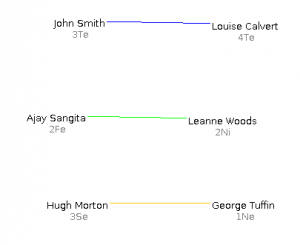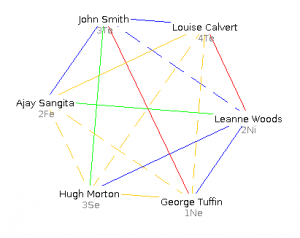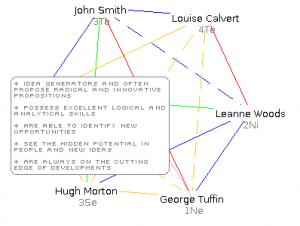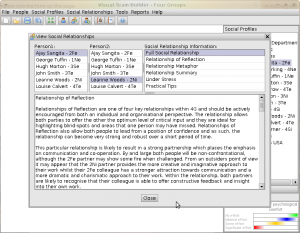An organisation's training and development syllabus typically comprises of discreet, best of breed approaches. Each approach is tailored to a particular topic such as leadership or communication skills but these topics are often unrelated to each other, creating developmental silos and making it hard to transfer learning from one situation to another.
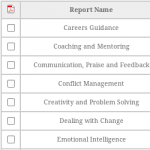 4G uses a common theoretical foundation for all of its 500,000 words of training and development materials, coaching modules and accreditation resources.
4G uses a common theoretical foundation for all of its 500,000 words of training and development materials, coaching modules and accreditation resources. This common foundation means that each new learning activity builds on the previous, simultaneously creating a holistic training and development syllabus and by extension, economies of learning and economies of scale.
A Training and Development Syllabus
How it Works
4G provides an integrated and holistic approach to training and development. There are many different capabilities of and components to 4G, but the 6 items below serve as a useful summary.
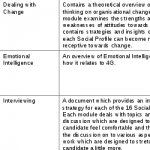 A 500,000 word suite of training and development materials
A 500,000 word suite of training and development materials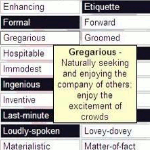 A valid, fair and innovative psychometric assessment tool
A valid, fair and innovative psychometric assessment tool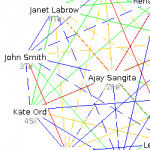 Predict behaviours, relationships and culture
Predict behaviours, relationships and culture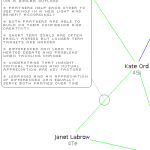 The Visual Team Builder software
The Visual Team Builder software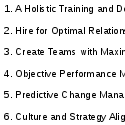 6 scalable business processes
6 scalable business processes Link relationships to financial metrics and KPIs
Link relationships to financial metrics and KPIs In addition and given it's predictive and re-usable output, 4G can be used on an ongoing basis and incorporated into a series of people management processes that generate an ROI and economies of scale, or economies of learning. This is in contrast with traditional approaches to training and development where the value generated is difficult to consistently replicate and scale.
A Training and Development Syllabus
In Practice
Building on the various components of 4G introduced above, there are three elements to creating a training and development syllabus.
1. Use Relationships to Link Training and Development to Business Processes
Workplace relationships are a common theme across multiple training and development topics. Engagement, leadership, communication, emotional intelligence and collaboration and others all acknowledge the role and value of relationships.
Similarly, relationships are a key component in the design and delivery of numerous processes and one-off projects.
By placing relationships at the forefront of training and development, a common approach can be defined and given the multiple and repeatable applications, economies of scale and economies of learning are easily generated.
Diagram 1 illustrates 3 Social Relationships.
The coloured lines represent the amount of effort or energy needed in order for each relationship to be productive. Green relationships require the least amount of effort and are the most productive. Blue relationships then need a little more effort, whilst yellow and red relationships (not shown in diagram 1) require even greater levels of effort and energy.
It should also be noted that while only 4 colours are used in the diagrams, 4G contains 14 specific Social Relationships and 16 different Social Profiles.
As a result of this greater granularity, diagram 3 offers a bullet point summary of Hugh Morton's Social Profile (3Se), while diagram 4 shows much more detailed information about the relationship between Ajay and Leanne (a Relationship of Reflection) and how coaching and development can help improve it further.
More detailed coaching and development information about people's Social Profile and their Social Relationships are available from the 4G reporting materials and the Visual Team Builder.
The syllabus is important for two reasons. Firstly, it creates a multi-level approach to learning that reflects people's own levels of expertise and experience and secondly, the ongoing reference to a syllabus ensures that economies of scale and economies of learning can be generated and sustained quickly and easily.
Similarly, relationships are a key component in the design and delivery of numerous processes and one-off projects.
By placing relationships at the forefront of training and development, a common approach can be defined and given the multiple and repeatable applications, economies of scale and economies of learning are easily generated.
Predicting and Visualising Relationships
Take a look at diagram 1. Through the use of 4G Social Relationships, it's possible to predict, in advance of people meeting each other, the type and nature of the relationship between any two people. Additionally, if people have already been working together for some time, Social Relationships offer detailed and precise descriptions of the relationships in question.Diagram 1 illustrates 3 Social Relationships.
The coloured lines represent the amount of effort or energy needed in order for each relationship to be productive. Green relationships require the least amount of effort and are the most productive. Blue relationships then need a little more effort, whilst yellow and red relationships (not shown in diagram 1) require even greater levels of effort and energy.
Predicting Relationships in Groups
While diagram 1 showed just 3 relationships, diagram 2 extends this example to show all 15 relationships amongst a group of 6.Coaching and Development Enhance Relationships
While diagrams 1 and 2 show a visual representation of team relationships, diagrams 3 and 4 highlight coaching and developmental information. This information creates an in-depth understanding of the relationships in question, along with providing a series of coaching and development recommendations to improve the relationships.It should also be noted that while only 4 colours are used in the diagrams, 4G contains 14 specific Social Relationships and 16 different Social Profiles.
As a result of this greater granularity, diagram 3 offers a bullet point summary of Hugh Morton's Social Profile (3Se), while diagram 4 shows much more detailed information about the relationship between Ajay and Leanne (a Relationship of Reflection) and how coaching and development can help improve it further.
More detailed coaching and development information about people's Social Profile and their Social Relationships are available from the 4G reporting materials and the Visual Team Builder.
Enabling Economies of Scale and Economies of Learning
The framework of 14 Social Relationships on the one hand combined with their applicability to multiple business processes on the other creates the foundations of a comprehensive training and development syllabus.The syllabus is important for two reasons. Firstly, it creates a multi-level approach to learning that reflects people's own levels of expertise and experience and secondly, the ongoing reference to a syllabus ensures that economies of scale and economies of learning can be generated and sustained quickly and easily.
2. Create a Personalised and Bespoke Training and Development Syllabus
The idea of a training and development syllabus is extended further via the use of individually customised 4G Coaching Modules.
There are 16 4G Coaching Modules. Each module is written in two parts. The first half contains the core concepts, while the second is custom written to reflect the different approaches adopted by people based on their Social Profile.
As a result of this personalisation, all of the coaching modules are customised to suit each person's perspective on the topic, in turn creating an individual and bespoke approach to training and development.
The table below provides an overview of each of the coaching modules and how they strengthen the training and development syllabus.
There are 16 4G Coaching Modules. Each module is written in two parts. The first half contains the core concepts, while the second is custom written to reflect the different approaches adopted by people based on their Social Profile.
As a result of this personalisation, all of the coaching modules are customised to suit each person's perspective on the topic, in turn creating an individual and bespoke approach to training and development.
The table below provides an overview of each of the coaching modules and how they strengthen the training and development syllabus.
| Name | Description |
|---|---|
| Careers Guidance | Introduces ideas around career development strengths creativity and different types of role and organisation amongst others. |
| Coaching and Mentoring | Contains a theoretical overview of the approaches and benefits of coaching in the workplace. This module provides an overall guide to how to coach and mentor each of the 16 Social Profiles. |
| Communication Praise and Feedback | A single document which provides a framework on how to optimise communication with each of the 16 Social Profiles. |
| Conflict Management | This module explores the benefits as well as negative impact of conflict in the workplace. Each module examines the individual?s likely reaction to conflict and how to improve this aspect of their work. |
| Creativity and Problem Solving | Examines each of the 16 Social Profile?s approach to creativity and problem solving. Each module looks at what motivates and stimulates individuals and how to encourage this aspect of their behaviour. |
| Dealing with Change | Contains a theoretical overview of current thinking on organisational change. Each module examines the strengths and weaknesses of attitudes towards change. It contains strategies and insights on how each Social Profile can become more receptive towards change. |
| Emotional Intelligence | An overview of Emotional Intelligence and how it relates to 4G. |
| Interviewing | A document which provides an interviewing strategy for each of the 16 Social Profiles. Each module deals with topics and areas of discussion which are designed to make the candidate feel comfortable and then move the discussion on to various aspects of work which are designed to stretch the candidate a little more. |
| Leadership | This module summarises some theoretical approaches to leadership as well as looking at each of the 16 Social Profiles? natural strengths and weaknesses when it comes to leadership. |
| Negotiation | Provides a theoretical overview of negotiation strategy and practice. Each of the modules provides a description of the natural attitude and negotiation style of each of the 16 Social Profiles. This module also includes some exercises. |
| Self Development | This module deals with elements of self-awareness and understanding looking at areas of natural strengths and weakness. It also looks at areas of work to avoid or those that are likely to cause stress. |
| Self Motivation and Stress | 4G points towards the thin line between being motivated and enthusiastic and stress and the loss of focus. This module provides a framework for all 16 Social Profiles to identify what motivates them. |
| Strategy and Organisational Culture | Looks at how an individual?s personality can impact on the general strategy or culture of an organisation. |
| The Art of Delegation | This module looks at how each of the 16 Social Profiles approach delegation and provides hints and tips on how to handle this aspect of work. |
| The First 100 Days | This module contains information on how to handle the transition to a new job or organisation. |
| Time Management | Explores various aspects of time management and looks at blockages and impediments. Each module deals with the likely distractions and issues which can affect each of the 16 Social Profiles. |
3. Generate Economies of Scale and Economies of Learning
Given the use of relationships in training and development, along with the personalised learning outcomes generated from the 4G Coaching Modules, it's possible to create a training and development syllabus with multiple levels of expertise and experience accounted for.
Just as the professional qualifications offered by the IT industry cater for different levels of ability and different applications, the materials from 4G can be tailored according to the objectives of the training and development syllabus in question.
Such a syllabus creates a widely applicable and transferable skill set that can be used by multiple groups within an organisation. For example top talent, new managers, subject matter experts, trainers, departmental heads and line managers all have different developmental needs which this syllabus can adapt to and cater for.
The provision of a training and development syllabus that combines a common theoretical foundation, uses relationships to link development activities to business processes, provides individually customised coaching modules and that caters to different objectives and levels of experience goes a long way to delivering economies of scale and economies of learning.
Just as the professional qualifications offered by the IT industry cater for different levels of ability and different applications, the materials from 4G can be tailored according to the objectives of the training and development syllabus in question.
Such a syllabus creates a widely applicable and transferable skill set that can be used by multiple groups within an organisation. For example top talent, new managers, subject matter experts, trainers, departmental heads and line managers all have different developmental needs which this syllabus can adapt to and cater for.
The provision of a training and development syllabus that combines a common theoretical foundation, uses relationships to link development activities to business processes, provides individually customised coaching modules and that caters to different objectives and levels of experience goes a long way to delivering economies of scale and economies of learning.
A Training and Development Syllabus
Return on Investment
Given the ideas above, 4G can be used on an ongoing basis as part of a training and development syllabus that generates an ROI, economies of scale and economies of learning.
This is in contrast with other approaches that are typically used in a fragmented fashion or as part of a one-off event where the value generated is difficult to scale and replicate.
This is in contrast with other approaches that are typically used in a fragmented fashion or as part of a one-off event where the value generated is difficult to scale and replicate.
